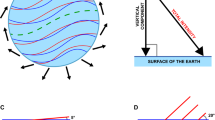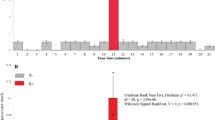Abstract
Elasmobranch fishes (sharks, skates, and rays) have been hypothesized to use the geomagnetic field as a cue for orienting and navigating across a wide range of spatial scales. Magnetoreception has been demonstrated in many invertebrate and vertebrate taxa, including elasmobranchs, but this sensory modality and the cognitive abilities of cartilaginous fishes are poorly studied. Wild caught yellow stingrays, Urobatis jamaicensis (N = 8), underwent conditioning to associate a magnetic stimulus with a food reward in order to elicit foraging behaviors. Behavioral conditioning consisted of burying magnets and non-magnetic controls at random locations within a test arena and feeding stingrays as they passed over the hidden magnets. The location of the magnets and controls was changed for each trial, and all confounding sensory cues were eliminated. The stingrays learned to discriminate the magnetic stimuli within a mean of 12.6 ± 0.7 SE training sessions of four trials per session. Memory probes were conducted at intervals between 90 and 180 days post-learning criterion, and six of eight stingrays completed the probes with a ≥75% success rate and minimum latency to complete the task. These results show the fastest rate of learning and longest memory window for any batoid (skate or ray) to date. This study demonstrates that yellow stingrays, and possibly other elasmobranchs, can use a magnetic stimulus as a geographic marker for the location of resources and is an important step toward understanding whether these fishes use geomagnetic cues during spatial navigation tasks in the natural environment.



Similar content being viewed by others
References
Adrianov GN, Brown HR, Ilyinsky OB (1974) Responses of central neurons to electrical and magnetic stimuli of the ampullae of Lorenzini in the Black Sea skate. J Comp Physiol 93:287–299
Akoev GN, Ilyinsky OB, Zadan PM (1976) Responses of electroreceptors (ampullae of Lorenzini) of skates to electric and magnetic fields. J Comp Physiol 106:127–136
Aronson LR, Aronson FR, Clark E (1967) Instrumental conditioning and light–dark discrimination in young nurse sharks. Bull Mar Sci 17:249–256
Babel JS (1967) Reproduction, life history, and ecology of the round stingray, Urolophus halleri. Cooper. Calif Fish Game Fish Bull 137:104
Beukemaj JJ (1970) Acquired hook-avoidance in the pike Esox lucius L. fished with artificial and natural baits. J Fish Biol 2:155–160
Blakemore R, Frankel RB (1981) Magnetic navigation in bacteria. Sci Am 245:58–65
Brown C (2001) Familiarity with the test environment improves the escape responses in the crimson spotted rainbowfish, Melanotaenia duboulayi. Anim Cogn 4:109–113
Brown C (2015) Fish intelligence, sentience and ethics. Anim Cogn 18:1–17
Brown HR, Ilyinsky OB (1978) The ampullae of Lorenzini in the magnetic field. J Comp Physiol 126:333–341
Clark E (1959) Instrumental conditioning of lemon sharks. Science 130:217–218
Clark E (1963) The maintenance of sharks in captivity, with a report on their instrumental conditioning. In: Gilbert PW (ed) Sharks and survival. DC Heath, Boston, pp 115–150
Dukas R (1999) Costs of memory: ideas and predictions. J Theor Biol 197:41–50
Eder SK, Cadiou H, Muhamed A, McNaughton PA, Kirschvink JL, Winklhofer M (2012) Magnetic characterization of isolated candidate magnetoreceptor cells. Proc Nat Acad Sci 109:12022–12027
Fahy DP (2004) Diel activity patterns, space utilization, seasonal distribution and population structure of the yellow stingray, Urobatis jamaicensis (Cuvier, 1817) in South Florida with comments on reproduction. (MS Thesis) Nova Southeastern University Oceanographic Center, Dania Beach, Florida, USA
Fuss T, Schluessel V (2015) Something worth remembering: visual discrimination in sharks. Anim Cogn 18:463–471
Fuss T, Bleckmann H, Schluessel V (2014a) Place learning prior to and after telencephalon ablation in bamboo and coral cat sharks (Chiloscyllium griseum and Atelomycterus marmoratus). J Comp Physiol A 200:37–52
Fuss T, Bleckmann H, Schluessel V (2014b) The shark Chiloscyllium griseum can orient using turn responses before and after partial telencephalon ablation. J Comp Physiol A 200:19–35
Graeber RC, Ebbesson SO, Jane JA (1973) Visual discrimination in sharks without optic tectum. Science 180:413–415
Gruber SH, Schneiderman N (1975) Classical conditioning of the nictitating membrane response of the lemon shark (Negaprion brevirostris). Behav Res Methods 7(5):430–434
Guttridge TL, Brown C (2014) Learning and memory in the Port Jackson shark, Heterodontus portusjacksoni. Anim Cogn 17:415–425
Guttridge TL, Myrberg AA, Porcher IF, Sims DW, Krause J (2009) The role of learning in shark behaviour. Fish Fish 10(4):450–469
Guttridge TL, van Dijk S, Stamhuis EJ, Krause J, Gruber SH, Brown C (2013) Social learning in juvenile lemon sharks, Negaprion brevirostris. Anim Cogn 16(1):55–64
Johnsen S, Lohmann KJ (2005) The physics and neurobiology of magnetoreception. Nat Rev Neurosci 6(9):703–712
Johnsen S, Lohmann KJ (2008) Magnetoreception in animals. Phys Today 61(3):29–35
Kalmijn AJ (1974) The detection of electric fields from inanimate and animate sources other than electric organs. In: Fessard A (ed) Handbook of sensory physiology III/3: electroreceptors and other specialized receptors in lower vertebrates. Springer, Berlin, pp 147–200
Kalmijn AJ (1978) Experimental evidence of geomagnetic orientation in elasmobranch fishes. In: Schmidt-Koening K, Keaton WT (eds) Animal migration, navigation, and homing. Springer, Berlin, pp 347–353
Kimber JA, Sims DW, Bellamy PH, Gill AB (2011) The ability of a benthic elasmobranch to discriminate between biological and artificial electric fields. Mar Biol 158(1):1–8
Kimber JA, Sims DW, Bellamy PH, Gill AB (2014) Elasmobranch cognitive ability: using electroreceptive foraging behaviour to demonstrate learning, habituation and memory in a benthic shark. Anim Cogn 17:55–65
Klimley AP (1993) Highly directional swimming by scalloped hammerhead sharks, Sphyrna lewini, and subsurface irradiance, temperature, bathymetry, and geomagnetic field. Mar Biol 117:1–22
Lisney TJ, Yopak KE, Montgomery JC, Collin SP (2008) Variation in brain organization and cerebellar foliation in Chondrichthyans: batoids. Brain Behav Evol 72:262–282
Lohmann KJ (1991) Magnetic orientation by hatchling loggerhead sea turtles Caretta caretta). J Exp Biol 155:37–49
Lohmann KJ, Johnsen S (2000) The neurobiology of magnetoreception in vertebrate animals. Trends Neurosci 23:153–159
Lohmann KJ, Willows AOD (1991) An identifiable molluscan neuron responds to changes in earth-strength magnetic fields. J Exp Biol 161:1–24
Lohmann KJ, Lohmann CMF, Endres CS (2008) The sensory ecology of ocean navigation. J Exp Biol 211:1719–1728
Mather JG, Baker RR (1981) Magnetic sense of direction in woodmice for route based navigation. Nature 291:152–155
Meyer CG, Holland KN, Papastamatiou YP (2005) Sharks can detect changes in the geomagnetic field. J R Soc Interface 2:129–130
Molet M, Miller RM (2014) Timing: an attribute of associative learning. Behav Processes 101:4–14
Nasby-Lucas N, Dewar H, Lam CH, Goldman KG, Domeier ML (2009) White shark offshore habitat: a behavioral and environmental characterization of the eastern pacific shared offshore foraging area. PLoS ONE 4(12):1–14
Nelson DR (1967) Hearing thresholds, frequency discrimination and acoustic orientation in the lemon shark, Negaprion brevirostris (Poey). Bull Mar Sci 17(3):741–767
O’Gower AK (1995) Speculations on a spatial memory for the Port Jackson shark (Heterodontus portusjacksoni)(Meyer)(Heterodontidae). Mar Freshw Res 46(5):861–871
Odling-Smee LC, Braithwaite VA (2003) The influence of habitat stability on landmark use during spatial learning in the three-spined stickleback. Anim Behav 65:701–707
Odling-Smee LC, Boughman JW, Braithwaite VA (2008) Sympatric species of threespine stickleback differ in their performance in a spatial learning task. Behav Ecol Sociobiol 68:1935–1945
Phillips JB (1986) Two magnetoreception pathways in a migratory salamander. Science 233:765–767
Quinn TP (1980) Evidence for celestial and magnetic compass orientation in lake migrating sockeye salmon fry. J Comp Physiol 137:243–248
Quinn TP (1996) Diet and seasonal feeding habits of the yellow stingray, Urolophus jamaicensis. (MS Thesis) Nova Southeastern University Oceanographic Center, Dania Beach, Florida, USA
Richtand NM, Woods SC, Berger SP, Strakowski SM (2001) D3 dopamine receptor, behavioral sensitization, and psychosis. Neurosci Behav Rev 25:427–443
Schluessel V (2015) Who would have thought that “Jaws” also has brains? Cognitive functions in elasmobranchs. Anim Cogn 18(1):19–37
Schluessel V, Bleckmann H (2005) Spatial memory and orientation strategies in the elasmobranch Potamotrygon motoro. J Comp Physiol A 191:695–706
Schluessel V, Bleckmann H (2012) Spatial learning and memory retention in the grey bamboo shark (Chiloscyllium griseum). Zool 115:346–353
Schluessel V, Beil O, Weber T, Bleckmann H (2014) Symmetry perception in bamboo sharks (Chiloscyllium griseum) and Malawi cichlids (Pseudotropheus sp.). Anim Cogn 17(5):1187–1205
Schwarze S, Bleckmann H, Schluessel V (2013) Avoidance conditioning in bamboo sharks (Chiloscyllium griseum and C. punctatum): behavioral and neuroanatomical aspects. J Comp Physiol A 199(10):843–856
Siciliano AM, Kajiura SM, Long JH, Porter MP (2013) Are you positive? Electric dipole polarity discrimination in the yellow stingray, Urobatis jamaicensis. Biol Bull 225:85–91
Sulikowski J (1996) A preliminary study of the population density, size distribution, age and growth of the stingray, Urolophus jamaicensis, in Southeastern, Florida. (MS Thesis) Nova Southeastern University Oceanographic Center, Dania Beach, Florida, USA
Tester AL, Kato S (1966) Visual target discrimination in blacktip sharks (Carcharhinus melanopterus) and grey sharks (C. menisorrah). Pac Sci 20:461–471
Thonhauser KE, Gutnick T, Byrne RA, Kral K, Burghardt GM, Kuba MJ (2013) Social learning in Cartilaginous fish (stingrays Potamotrygon falkneri). Anim Cogn 16(6):927–932
Vaudo JJ, Lowe CG (2006) Movement patterns of the round stingray Urobatis halleri (Cooper) near a thermal outfall. J Fish Biol 68:1756–1766
Walker MM, Bitterman ME (1989) Honeybees can be trained to respond to very small changes in geomagnetic field intensity. J Exp Biol 145:489–494
Walker BK, Sherman RL (2001) Gross brain morphology in the yellow stingray, Urobatis jamaicensis. Fla Scientist 64(4):246–249
Walker MM, Diebel CE, Kirschvink JL (2003) Detection and use of the Earth’s magnetic field by aquatic vertebrates. In: Collin SP, Marshall NJ (eds) Sensory processing in aquatic environments. Springer, New York, pp 53–74
Webster MM, Laland KN (2013) The learning mechanism underlying public information use in ninespine sticklebacks (Pungitius pungitius). J Comp Psychol 127:154–165
Weng KC, Castilho PC, Morrisette JM, Landeira-Fernandez AM, Holts DB, Schallert RJ, Goldman KJ, Block BA (2005) Satellite tagging and cardiac physiology reveal niche expansion in salmon sharks. Science 310:104–106
Wilkens LA, Hofmann MH (2005) Behavior of animals with passive, low-frequency electrosensory systems. In: Bullock TH, Hopkins CD, Popper AN, Fay RR (eds) Electroreception. Springer, New York, pp 229–263
Wiltschko W (1968) Über den Einfluß statischer Magnetfelder auf die Zugorientierung der Rotkehlchen (Erithacus rubecula). Z. Tierpsychol 25:537–558
Yopak KE (2012) Neuroecology of cartilaginous fishes: the functional implications of brain scaling. J Fish Biol 80:1968–2023
Acknowledgements
This research was supported by grants to KCN from the Florida Atlantic University (FAU) Graduate Grant, the Dr. Vincent Saurino Fellowship from the FAU Department of Biological Sciences, the Edward C. Raney Award from the American Society of Ichthyologists and Herpetologists, and the Donald R. Nelson Award from the American Elasmobranch Society. We thank S. Creager, A. Murakami, E. Cave, T. Gunn, J. Noble, B. Bowers, S. Ramirez, and C. Prince for help with stingray collection and husbandry, and R. Stackman, M. Salmon, and E. Gerstein for assistance with experimental design and animal training protocols.
Author information
Authors and Affiliations
Corresponding author
Ethics declarations
Conflict of interest
The authors declare that they have no conflict of interest.
Data availability
The datasets created during and/or analyzed during the current study are available from the corresponding author upon reasonable request.
Human and animal rights
All applicable international, national, and institutional guidelines for the care and use of animals were followed. All procedures performed in studies involving animals were in accordance with the ethical standards of the Florida Atlantic University Institutional Animal Care and Use Committee.
Rights and permissions
About this article
Cite this article
Newton, K.C., Kajiura, S.M. Magnetic field discrimination, learning, and memory in the yellow stingray (Urobatis jamaicensis). Anim Cogn 20, 603–614 (2017). https://doi.org/10.1007/s10071-017-1084-8
Received:
Revised:
Accepted:
Published:
Issue Date:
DOI: https://doi.org/10.1007/s10071-017-1084-8




